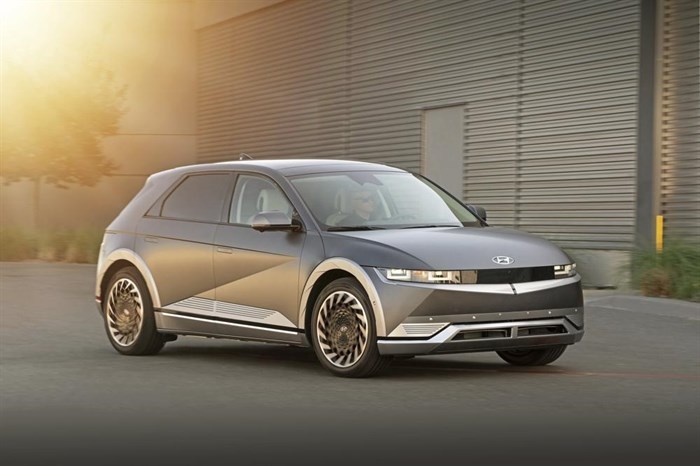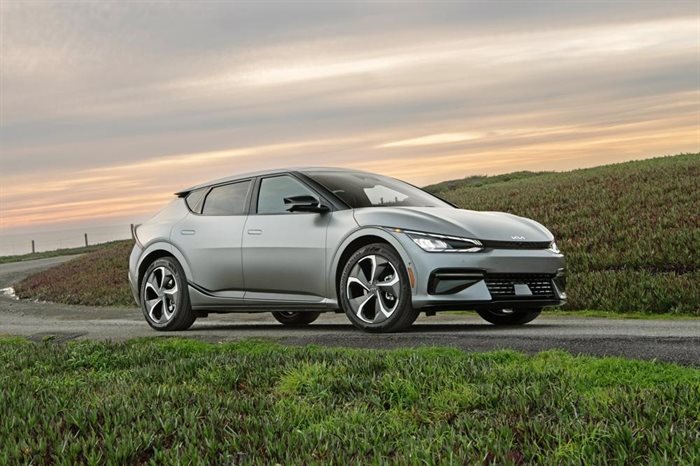Edmunds: 2022 Hyundai Ioniq 5 vs. 2022 Kia EV6

Seemingly overnight, the all-electric small SUV segment has exploded with options from both startup companies and established automotive players. Two of the most promising new models come from sister brands Hyundai and Kia.
The Hyundai Ioniq 5 flaunts a retro-futuristic design in a spacious, fast-charging form, while the Kia EV6 wears a sleek, future-facing look to match its excellent performance. Prospective buyers are likely to consider both since they’re very similar underneath the sheetmetal. But are there enough differences to make one stand out over the other? Edmunds’ experts compared them to find out.
RANGE AND CHARGING TIMES
Though the EV6 and Ioniq 5 share the same powertrains and battery technology, range figures do vary. Hyundai and Kia both offer their EVs in three trims with two battery packs. In entry-level SE trim, the Ioniq 5 uses a standard battery pack and single electric motor for an EPA-estimated range of 220 miles on a full charge. Kia’s EV6 Light trim uses the same pairing to deliver 232 miles.
The longest-range Ioniq 5 and EV6 use a higher-capacity battery and rear-wheel-drive motor to exceed 300 miles on a single charge — 303 miles for the Hyundai and 310 miles for the Kia. In dual-motor and all-wheel-drive flavor, though, both models take a hit on range: 256 and 274 miles, respectively.
But EPA numbers aren’t enough for us at Edmunds, which is why we conducted our own real-world range test on the dual-motor versions. The Hyundai and Kia both overperformed compared to their EPA estimates: 283 miles on a full charge for the Kia and 270 for the Hyundai.
Both EVs are notable in their compatibility with public high-powered DC fast-charging stations. At a peak 350-kW DC fast charge, the EV6 or Ioniq will jump from 10% to 80% capacity in just 18 minutes. Via a Level 2 outlet, each car can replenish its battery in under seven hours.
There are small differences here, but not enough to tip the scales.
Winner: Tie
PERFORMANCE
In entry-level SE trim, the Ioniq 5 uses a single 168-horsepower electric motor to power the rear wheels. Kia’s EV6 Light trim uses the same pairing to deliver 167 horsepower. In dual-motor and all-wheel-drive form, both the Ioniq 5 and EV6 produce 320 horsepower and sprinted to 60 mph in an impressively quick 4.7 seconds in Edmunds’ testing.
It’s a tie so far, but there is a difference between how these EVs feel. If you want a fun-to-drive EV SUV, few options are as entertaining as the EV6. The Kia’s suspension tuning is stiffer than the Hyundai’s, and the whole car is distinctly a tad sportier than the Ioniq 5. The EV6's sharp steering makes it responsive and a little easier to control around turns.
Winner: EV6
STYLING AND COMFORT
Proportionally, the Kia EV6 and Hyundai Ioniq 5 are nearly identical, but their design strategies vary substantially. Hyundai gives the Ioniq 5 a distinctive 1980s hatchback retro vibe, with 8-bit pixel-shaped lights and edgy panels. Kia styles the EV6 in visual agility, with curvaceous bodywork and contemporary light signatures. We appreciate both aesthetics, but it’s a bigger question whether the Ioniq 5 design will age gracefully.
Inside, the Ioniq 5 shows fresh styling to match its quirky exterior. The front seats are available with heating and ventilation, soft-touch materials adorn most surfaces, and a sliding center console expands storage options. The EV6's cabin has a slick, sporty ambiance that will feel more familiar to first-time EV owners. The front seats are also available with heating and ventilation but border a fixed center console clad in hard plastics.
The Hyundai makes better use of space due to its boxier shape, and it delivers more passenger and cargo volume. It also rides softer and filters road imperfections more effectively than the Kia, which is more susceptible to roughly riding over bumps and potholes.
Winner: Ioniq 5
VALUE AND WARRANTY
Hyundai’s Ioniq 5 starts at $45,245 in SE trim with the smaller battery pack. A loaded dual-motor all-wheel-drive Limited variant stickers for $56,245. These prices exclude a $7,500 federal tax credit.
Kia’s EV6 base Light trim has a starting price of $42,115, while the range-topping GT-Line AWD retails for $57,155. These bookend figures, and each trim in between, can be offset by a $7,500 tax credit.
Both EVs are covered by a five-year/60,000-mile new car warranty, roadside coverage with unlimited miles, and a 10-year/100,000-mile battery warranty. And overall, you’re getting similar amounts of standard and optional features.
Winner: Tie
EDMUNDS SAYS:
The 2022 Kia EV6 peppers an excellent EV platform with sporty flavour, but Hyundai’s Ioniq 5 bundles similar stats with a more comfortable drive and a roomier cabin. Between these electric SUV siblings, we’d choose the Hyundai.
Author bio:
This story was provided to The Associated Press by the automotive website Edmunds.
Miles Branman is a contributor at Edmunds and is on Twitter




